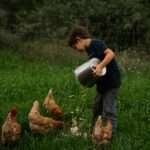In the enchanting world of chicken keeping, there’s a moment of anticipation and joy that arrives with the daily ritual of egg collection. For children, this ritual is not just about gathering breakfast ingredients; it’s a gateway to a realm of hands-on learning, responsibility, and the thrill of connecting with nature. Teaching kids to handle eggs safely is a valuable endeavor that empowers them with essential life skills while nurturing a sense of wonder and care for their feathered companions.
Teaching Kids to Handle Eggs: Building Confidence and Care
As fragile as they may seem, eggs are remarkable packages of potential, each one cradling the possibility of new life. Teaching kids how to hold an egg with care and confidence is a foundational step in their chicken-keeping journey.
Step 1: Gentle Grasp Begin by demonstrating the gentle grasp needed to hold an egg. Show kids how to cradle the egg in their hand, using their fingertips to create a secure yet gentle hold. Explain that applying too much pressure can crack the egg, while holding it too loosely may result in dropping it.
Step 2: Hand Positioning Guide kids through the proper hand positioning. Have them place the egg in the center of their palm, with their fingers naturally curling around it. Encourage them to find a comfortable and stable grip that feels secure.
Step 3: Confidence Through Practice Reassure kids that confidence comes with practice. Start with hard-boiled eggs to eliminate the worry of breakage. As they become more comfortable, gradually introduce them to handling fresh eggs. Emphasize the importance of patience and the understanding that accidents can happen.

Navigating Broody Hens: Collecting Eggs Without a Fuss
While the egg collection process is usually straightforward, the presence of a broody hen can introduce an element of protective behavior that requires a delicate approach.
Step 1: Timing is Key Explain to kids that timing is crucial when collecting eggs from a broody hen’s nest. Choose a moment when the hen is momentarily away from the nest, perhaps engaged in dust bathing or foraging.
Step 2: Distraction Technique To safely access eggs under a broody hen, suggest a distraction technique. Encourage kids to gently toss a treat or a handful of scratch grains a short distance away from the nest. This diversion can give them the opportunity to quickly collect the eggs while the hen is preoccupied.
Step 3: Confidence-Building Acknowledge that collecting eggs from a broody hen requires confidence and composure. Assure kids that as they become more experienced in chicken care, their ability to navigate these situations will grow, fostering a deeper understanding of the chickens’ behavior and needs.
Choosing the Right Container: Safe Egg Transport
Once eggs are collected, the next step is to transport them safely to their intended destination. Selecting the right container plays a crucial role in ensuring the eggs remain intact during transit.
Step 1: Egg Cartons Explain that egg cartons are a popular and practical option for transporting eggs. Demonstrate how to gently place each egg into the individual compartments, ensuring they are snug and secure.
Step 2: Baskets with Straw For a rustic and charming alternative, suggest using a basket lined with soft straw. Show kids how to create a cozy bed for the eggs by arranging a layer of straw at the bottom of the basket.
Step 3: Handling with Care Highlight the importance of gentle handling when placing eggs in the chosen container. Remind kids that eggs are delicate and can crack if dropped or jostled.
In the following sections of this guide, we will delve further into the significance of maintaining proper hand hygiene when handling eggs, addressing common concerns that kids might have, and ultimately fostering a positive and enriching experience as they engage with the fascinating world of chicken keeping. Through these steps, kids can become adept egg handlers, gaining valuable skills and nurturing a lifelong appreciation for nature’s treasures.

Promoting Hand Hygiene: Keeping Eggs Clean and Safe
As you endeavour through teaching kids how to handle eggs, it’s crucial to emphasize the importance of maintaining clean and safe hands throughout the process.
Step 1: Before and After Handling Teach children the essential practice of washing their hands before and after handling eggs. Explain that clean hands prevent the transfer of dirt, bacteria, or contaminants to the eggs. Make it a routine for kids to wash their hands thoroughly with soap and water before and after each egg-collecting session.
Step 2: Proper Hand-Washing Technique Guide kids through the proper hand-washing technique to ensure effective cleansing. Encourage them to lather their hands with soap, scrubbing all surfaces for at least 20 seconds—about the time it takes to sing the “Happy Birthday” song twice. Rinse hands thoroughly with running water and dry them with a clean towel.
Step 3: A Hygienic Approach Discuss the importance of avoiding direct contact between unwashed hands and collected eggs. Remind kids that clean hands contribute to the safety and quality of the eggs, especially if the intention is to consume them.
Understanding Reluctance and Building Confidence
While the enchantment of egg collection is undeniable, it’s natural for kids to encounter moments of hesitation. Understanding the sources of reluctance and addressing them with empathy is key to building their confidence.
Step 1: Addressing Concerns Acknowledge that some kids might be hesitant to handle eggs due to reasons like the presence of chicken droppings or the fear of being pecked by a protective hen. Create an open space for them to express their concerns without judgment.
Step 2: Gloves or Tools Offer practical solutions to alleviate these concerns. Suggest the use of gloves as a barrier between hands and eggs, providing an added layer of protection. Alternatively, introduce the idea of using a designated egg-collecting tool, such as a scoop or small basket with a handle.
Step 3: Gradual Exposure Encourage kids to approach egg collection at their own pace. If they’re apprehensive, begin with observing and assisting while an adult handles the eggs. As their confidence grows, they can gradually take on a more active role.
Creating a Positive Experience: Setting Kids Up for Success
Turning egg collection into a positive and rewarding experience requires a nurturing environment and thoughtful strategies.
Step 1: Involvement from Start to Finish Involve kids in every step of the egg collection process, from checking nesting boxes for fresh eggs to placing them in the container. This comprehensive involvement fosters a sense of accomplishment and connection.
Step 2: Praise and Encouragement Celebrate each successful egg collection with praise and encouragement. Acknowledge kids for their efforts, no matter how small, and emphasize the importance of their role in caring for the chickens.
Step 3: Patient Guidance Practice patience as kids develop their skills. Be there to offer guidance and support, answering their questions and addressing their concerns. With time and practice, their confidence will grow, and egg collection will become a joyful and empowering task.
In the upcoming sections of this guide, we will explore the benefits of teaching kids how to handle eggs, delve into the deeper educational aspects of chicken keeping, and conclude with the profound impact that this simple yet meaningful activity can have on children’s personal growth and development. By nurturing a positive and enriching egg-collecting experience, parents, guardians, and educators can instill valuable life skills and a lifelong appreciation for the wonders of nature.

The Power of Hands-On Learning When Teaching Kids How to Handle Eggs
As children engage in the captivating practice of egg collection, they embark on a remarkable journey of discovery and education that extends far beyond the coop.
Learning Responsibility: Through the act of gathering eggs, kids learn responsibility in a tangible way. They come to understand that the care they provide directly impacts the well-being of the chickens and the quality of the eggs. This hands-on responsibility fosters a sense of accountability and a deeper connection to the natural world.
Observing Nature: Egg collection offers an opportunity for kids to observe nature’s processes up close. As they witness hens laying eggs, they gain insights into the biology and behaviors of these remarkable creatures. This exposure to the intricacies of life encourages curiosity and a lifelong love for learning.
Scientific Exploration: Encourage children to ask questions and explore the science behind egg collection. Discuss concepts such as ovulation, egg development, and the role of calcium in forming eggshells. Engage kids in conversations that promote critical thinking and spark their interest in understanding the world around them.
Mathematical Connections: Make math meaningful by incorporating it into egg collection. Have kids count the number of eggs collected each day and track the total egg production over time. Encourage them to calculate averages and explore patterns in egg-laying behavior. This practical application of math transforms a seemingly routine task into a valuable learning opportunity.
Empathy and Compassion: Handling eggs teaches kids empathy and compassion for the animals in their care. They come to recognize that each egg represents the effort and energy expended by the hens. This realization nurtures a deeper appreciation for the chickens’ contributions and well-being.
Building Confidence and Life Skills Through Egg Collection
Egg collection is more than just a chore; it’s a gateway to building essential life skills and nurturing personal growth.
Confidence and Competence: As kids master the art of egg collection, their confidence soars. They take pride in their ability to handle eggs delicately and efficiently. This newfound confidence extends beyond the coop, empowering children to tackle challenges and new experiences with a sense of capability.
Resilience and Adaptability: Egg collection exposes kids to the unpredictability of nature. They learn that not every egg will be perfect, and that’s okay. This understanding promotes resilience and adaptability—qualities that are valuable in navigating life’s twists and turns.
Attention to Detail: Successful egg collection requires attention to detail and careful observation. Children develop keen observation skills as they examine each egg for cracks or irregularities. This level of attentiveness carries over into other aspects of their lives, enhancing their ability to notice and appreciate subtleties.
A Sense of Achievement: Each egg collected becomes a tangible achievement. Kids experience the satisfaction of contributing to their family’s sustenance and the joy of seeing their efforts materialize in the form of a nutritious meal. This sense of achievement instills a positive work ethic and a deep understanding of the rewards of hard work.

Teaching Kids How to Handle Eggs
The act of teaching kids to handle and collect eggs is far more than a practical task; it’s a journey of growth, education, and connection. From fostering responsibility and empathy to developing life skills and igniting a passion for learning, egg collection is a simple yet profound activity that enriches children’s lives in countless ways.
As parents, guardians, and educators, we have the privilege of guiding children through this rewarding experience. By setting a positive example, providing patient guidance, and creating an environment that encourages curiosity and exploration, we can empower the next generation with the tools they need to thrive and make a meaningful impact in their world.
So, gather your egg-collecting basket, invite your kids to join you, and embark on a journey of discovery and learning that will leave a lasting imprint on their hearts and minds. As they hold those delicate treasures in their hands, they hold in their grasp the seeds of responsibility, empathy, and a lifelong love for the wonders of the natural world.





